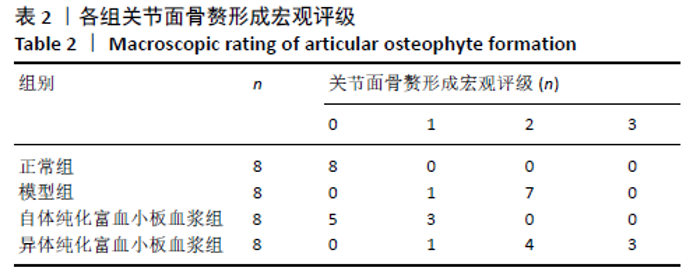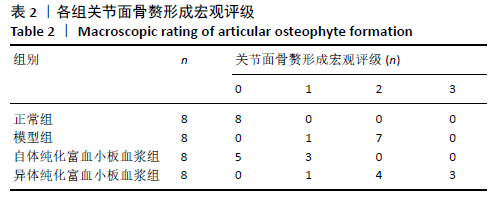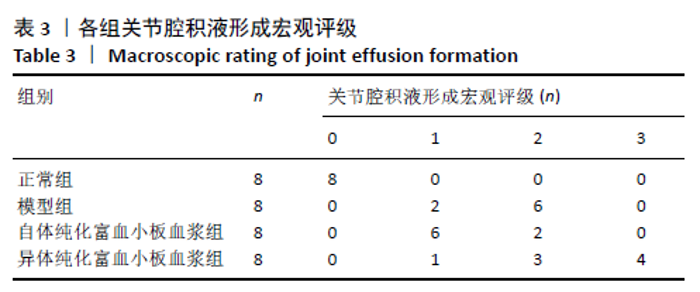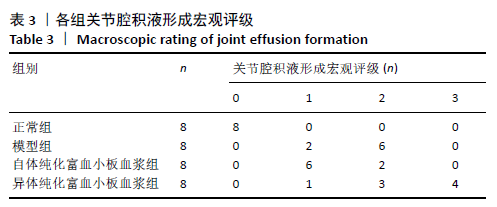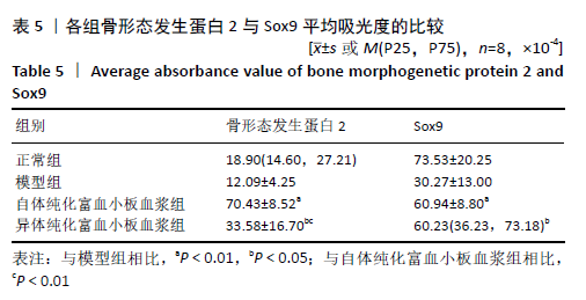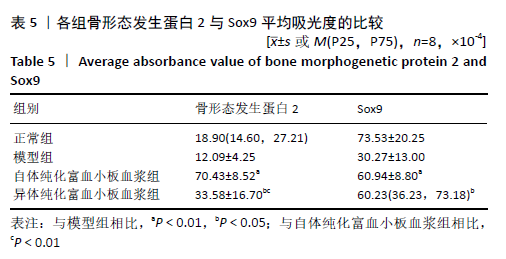Chinese Journal of Tissue Engineering Research ›› 2021, Vol. 25 ›› Issue (26): 4123-4129.doi: 10.12307/2021.109
Previous Articles Next Articles
The difference between autologous and allogeneic purified platelet-rich plasma in the treatment of rabbit knee osteoarthritis
Zhao Luting1, Fang Qilin1, Tang Haiyan2, Xu Fangyuan3
- 1The First People’s Hospital of Ziyang, Ziyang 641300, Sichuan Province, China; 2Zigong First People’s Hospital, Zigong 643000, Sichuan Province, China; 3The Affiliated Hospital of Southwest Medical University, Luzhou 646000, Sichuan Province, China
-
Received:2020-05-26Revised:2020-05-28Accepted:2020-08-29Online:2021-09-18Published:2021-04-26 -
Contact:Xu Fangyuan, The Affiliated Hospital of Southwest Medical University, Luzhou 646000, Sichuan Province, China E-mail:x5144@163.com -
About author:Zhao Luting, Master, Physician, The First People’s Hospital of Ziyang, Ziyang 641300, Sichuan Province, China -
Supported by:a grant from Sichuan Provincial Education Department, No. 12ZB255 (to XFY)
CLC Number:
Cite this article
Zhao Luting, Fang Qilin, Tang Haiyan, Xu Fangyuan. The difference between autologous and allogeneic purified platelet-rich plasma in the treatment of rabbit knee osteoarthritis[J]. Chinese Journal of Tissue Engineering Research, 2021, 25(26): 4123-4129.
share this article
Add to citation manager EndNote|Reference Manager|ProCite|BibTeX|RefWorks
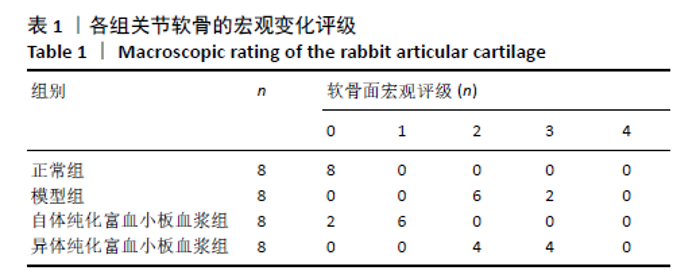
自体纯化富血小板血浆组关节软骨宏观评级较模型组低(Z=-3.554,P < 0.01),其骨赘情况亦较模型组改善(Z= -3.427,P < 0.01),且与正常组比较差异无显著性意义(Z= -3.000,P > 0.05)。异体纯化富血小板血浆组关节软骨及骨赘与模型组相比改善均不明显(P=0.317,0.178),且自体纯化富血小板血浆组的关节软骨及骨赘宏观评级均优于异体纯化富血小板血浆组(P均< 0.01)。就关节液宏观评级而言,自体纯化富血小板血浆组、异体纯化富血小板血浆组与模型组相比较差异无显著性意义(Z=-1.936,P=0.053;Z= -1.875,P=0.061),而自体纯化富血小板血浆组关节液情况优于异体纯化富血小板血浆组(Z=-2.697,P < 0.01)。各组大体标本宏观评级见表1-3。"
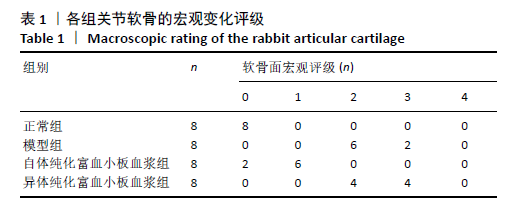
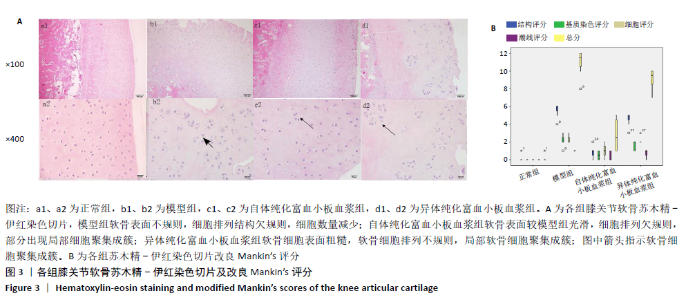
2.2 各组软骨组织学观察 正常组大部分软骨表面平滑,部分表面不规则,软骨细胞排列整齐,细胞大小一致,细胞基质染色均匀,潮线完整;模型组软骨表面不规则,出现裂隙,细胞排列结构欠规则,与正常组相比,软骨细胞层明显变薄,细胞数量减少,局部软骨细胞聚集成簇,潮线被破坏;自体纯化富血小板血浆组软骨表面较模型组光滑,无裂隙、溃烂形成,细胞排列欠规则,部分软骨细胞固缩,脂质变性细胞增多,部分出现局部细胞聚集成簇,基质染色轻度减少,部分潮线紊乱;异体纯化富血小板血浆组软骨细胞表面粗糙,出现裂隙,部分深达钙化带,软骨细胞层变薄,排列不规则,局部软骨细胞聚集成簇,甚至细胞数量过少,基质染色中度减少,潮线完整性被破坏,见图3。"
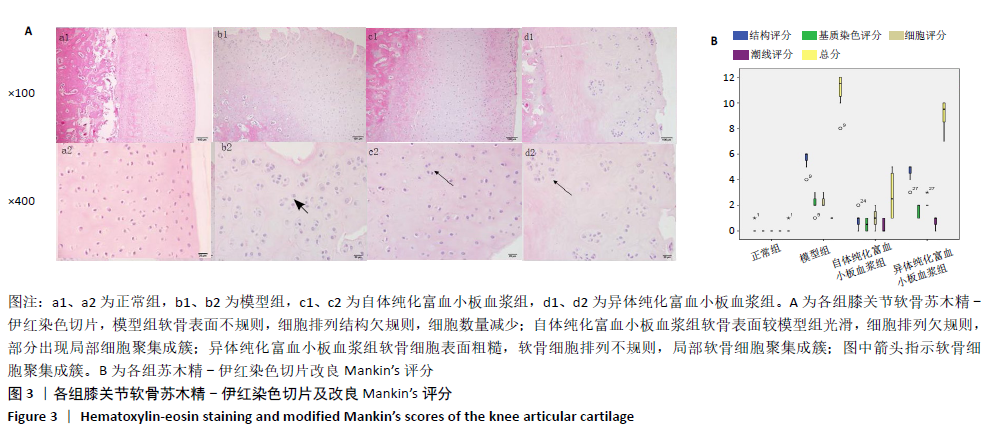
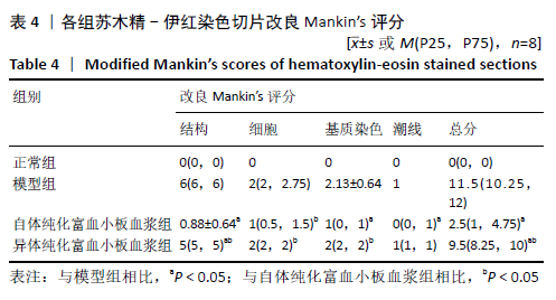
与模型组相比,自体纯化富血小板血浆组在软骨结构、基质染色、细胞、潮线等各方面均明显改善,各项评分均低于模型组(P均< 0.05)。与模型组相比,异体纯化富血小板血浆组对软骨结构有改善(P < 0.05),但其对细胞排列、基质染色、潮线的改善不明显,评分与模型组相比差异无显著性意义(Z= -0.620,P=0.535;Z= -1.586,P=0.143;Z=-1.464,P=0.143)。自体纯化富血小板血浆组的软骨结构、细胞、基质染色评分均优于异体纯化富血小板血浆组(P < 0.05)。从改良Mankin’s评分总分可见:自体纯化富血小板血浆组、异体纯化富血小板血浆组改良Mankin’s评分较模型组均有降低(Z=-3.419、P < 0.01;Z= -2.53,P < 0.05),但自体纯化富血小板血浆组降低得更为明显,且自体纯化富血小板血浆组与异体纯化富血小板血浆组评分存在差异(Z=-3.419,P < 0.01)。各组改良Mankin’s评分见图3、表4。"
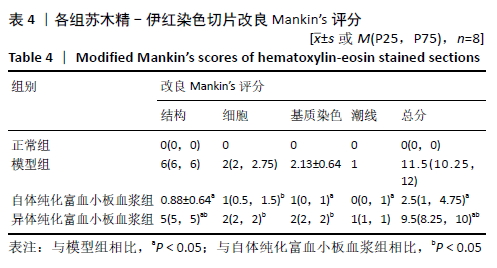

2.3 各组关节软骨免疫组化分析 2.3.1 骨形态发生蛋白2免疫组化 光镜下软骨细胞骨形态发生蛋白2免疫组化阳性表达为软骨细胞核、质或膜有棕色颗粒附着。正常组软骨细胞分布均匀,骨形态发生蛋白2在过渡层见中可见部分软骨细胞胞质浅染色,浅表层、放射层、钙化层均未见明显阳性细胞;模型组表面粗糙,软骨分层不明显,细胞排列紊乱,局部细胞聚集成簇,仅在过渡层见中可见少量胞质极浅染色;自体纯化富血小板血浆组表面规则,软骨细胞排列整齐,在软骨过渡层和放射层可见大量细胞胞质内有棕褐色颗粒,浅表层及钙化层表达相对较弱;异体纯化富血小板血浆组表面欠规则,局部细胞聚集成簇,在浅表层及过渡层见可见大量软骨细胞的胞质中有棕褐色颗粒,放射层可见少量胞质浅染,钙化层无表达。各组骨形态发生蛋白2免疫组化染色见图4。"

| [1]周明,赵晨钰,高谦,等.自体去白细胞富血小板血浆治疗膝骨关节炎的早期临床疗效观察[J].解放军医学院学报,2019,40(8):757-759,763. [2]ELIK H, DOĞU B, YıLMAZ F, et al. The efficiency of platelet-rich plasma treatment in patients with knee osteoarthritis. J Back Musculoskelet Rehabil. 2020;33(1):127-138. [3]沈恺.富血小板血浆与透明质酸钠关节腔内注射治疗膝骨关节炎的疗效观察[J].世界最新医学信息文摘,2019,19(88):104-106. [4]BURCHARD R, HUFLAGE H, SOOST C, et al. Efficiency of platelet-rich plasma therapy in knee osteoarthritis does not depend on level of cartilage damage. J Orthop Surg Res. 2019;14(1):153. [5] 孙鲁宁,赵燕华,黄桂成,等.木瓜蛋白酶诱导膝关节骨关节炎模型兔滑膜病理变化与药物注射时间的关系[J].中国组织工程研究与临床康复,2011,15(50):9311-9313. [6]沈景寿,张晶,胡毓诗,等.膝关节骨关节炎诱导性动物模型研究进展[J].中国运动医学杂志,2019,38(8):726-730. [7] PEREZ AG, LANA JF, RODRIGUES AA, et al. Relevant aspects of centrifugation step in the preparation of platelet-rich plasma. ISRN Hematol. 2014;2014:1-8. [8] ALMASRY SM, SOLIMAN HM, EL-TARHOUNY SA, et al. Platelet rich plasma enhances the immunohistochemical expression of platelet derived growth factor and vascular endothelial growth factor in the synovium of the meniscectomized rat models of osteoarthritis. Ann Anat. 2015;197: 38-49. [9] LAVERTY S, GIRARD CA, WILLIAMS JM, et al. The OARSI histopathology initiative - recommendations for histological assessments of osteoarthritis in the rabbit. Osteoarthritis Cartilage. 2010;18 Suppl 3:S53-65. [10]常琦,阮贞,王宪伟,等.骨关节炎模型大鼠血清骨保护素及软骨下骨降钙素基因相关肽、神经生长因子表达及Mankin评分变化[J].中国老年学杂志,2019,39(4):909-913. [11] KNOP E, PAULA LED, FULLER R. Platelet-rich plasma for osteoarthritis treatment. Revista Brasileira de Reumatologia (English Edition). 2016;56(2):152-164. [12] WU J, HUANG JF, QIN XX, et al. Platelet-rich plasma inhibits Wnt/beta-catenin signaling in rabbit cartilage cells activated by IL-1beta. Int Immunopharmacol. 2018; 55:282-289. [13] ASJID R, FAISAL T, QAMAR K, et al. Platelet-rich Plasma-induced Inhibition of Chondrocyte Apoptosis Directly Affects Cartilage Thickness in Osteoarthritis. Cureus. 2019;11(11): e6050. [14] KHATAB S, VAN BUUL GM, KOPS N, et al. Intra-articular Injections of Platelet-Rich Plasma Releasate Reduce Pain and Synovial Inflammation in a Mouse Model of Osteoarthritis. Am J Sports Med. 2018;46(4): 977-986. [15]陈尉,张国如,何健东等.富血小板血浆调节滑膜炎保护软骨细胞[J].中国组织工程研究,2020,24(29):4643-4649. [16]李弯月,钱宝延,庄卫生,等.自体富血小板血浆注射联合电针治疗膝骨关节炎的疗效观察[J].中国康复,2020,35(3):143-146. [17]黄凯华,吴志浩,张子亮,等.透明质酸、富血小板血浆及两者联合应用对膝骨关节炎的疗效评估[J].中国骨质疏松杂志,2019,25(12):1707-1711. [18] 吕敏.同种异体富血小板血浆标准化制备的研究[D].西安:第四军医大学,2013. [19] 高伟.同种异体富血小板血浆对兔骨缺损修复作用的实验研究[D].石家庄:河北医科大学,2017. [20] LIAO X, LIANG JX, LI SH, et al. Allogeneic Platelet-Rich Plasma Therapy as an Effective and Safe Adjuvant Method for Chronic Wounds. J Surg Res. 2020; 246: 284-291. [21] JO CH, SHIN JS, LEE SY, et al. Allogeneic platelet-rich plasma for rotator cuff repair. Acta Ortop Bras. 2017; 25(1): 38-43. [22] GREIMERS L, DRION PV, COLIGE A, et al. Effects of Allogeneic Platelet-Rich Plasma (PRP) on the Healing Process of Sectioned Achilles Tendons of Rats: A Methodological Description. J Vis Exp. 2018;(133):55759. [23] KANWAT H, SINGH DM, KUMAR CD, et al. The effect of intra-articular allogenic platelet rich plasma in Dunkin-Hartley guinea pig model of knee osteoarthritis. Muscles Ligaments Tendons J. 2018;7(3):426-434. [24] MONCHARMONT P. Platelet component transfusion and alloimmunization: Where do we stand?[J]. Transfus Clin Biol, 2018; 25(3): 172-178. [25] TRAN JQ, MUENCH MO, HEITMAN JW, et al. Allogeneic major histocompatibility complex antigens are necessary and sufficient for partial tolerance induced by transfusion of pathogen reduced platelets in mice. Vox Sang. 2019;114(3): 207-215. [26]朱瑜琪,王智耀,张帅等.细胞因子与膝骨关节炎关节软骨损伤的修复[J].中国组织工程研究,2017,21(36):5873-5878. [27]史文涛,戴瑶,毕士奇,等.不同状态BMP-2对体外EMSCs成骨分化的作用[J].中国矫形外科杂志,2019,27(3):261-267. [28] VAN BEUNINGEN HM, GLANSBEEK HL, VAN DER KRAAN PM, et al. Differential effects of local application of BMP-2 or TGF-beta 1 on both articular cartilage composition and osteophyte formation. Osteoarthritis Cartilage. 1998;6(5): 306-317. |
| [1] | Zhang Chao, Lü Xin. Heterotopic ossification after acetabular fracture fixation: risk factors, prevention and treatment progress [J]. Chinese Journal of Tissue Engineering Research, 2021, 25(9): 1434-1439. |
| [2] | Chen Jiming, Wu Xiaojing, Liu Tianfeng, Chen Haicong, Huang Chengshuo. Effects of silymarin on liver injury and bone metabolism induced by carbon tetrachloride in mice [J]. Chinese Journal of Tissue Engineering Research, 2021, 25(8): 1224-1228. |
| [3] | Tan Jingyu, Liu Haiwen. Genome-wide identification, classification and phylogenetic analysis of Fasciclin gene family for osteoblast specific factor 2 [J]. Chinese Journal of Tissue Engineering Research, 2021, 25(8): 1243-1248. |
| [4] | Wu Xun, Meng Juanhong, Zhang Jianyun, Wang Liang. Concentrated growth factors in the repair of a full-thickness condylar cartilage defect in a rabbit [J]. Chinese Journal of Tissue Engineering Research, 2021, 25(8): 1166-1171. |
| [5] | Li Jing, Xie Jianshan, Cui Huilin, Cao Ximei, Yang Yanping, Li Hairong. Expression and localization of diacylglycerol kinase zeta and protein kinase C beta II in mouse back skin with different coat colors [J]. Chinese Journal of Tissue Engineering Research, 2021, 25(8): 1196-1200. |
| [6] | Lun Zhigang, Jin Jing, Wang Tianyan, Li Aimin. Effect of peroxiredoxin 6 on proliferation and differentiation of bone marrow mesenchymal stem cells into neural lineage in vitro [J]. Chinese Journal of Tissue Engineering Research, 2021, 25(7): 1014-1018. |
| [7] | Duan Liyun, Cao Xiaocang. Human placenta mesenchymal stem cells-derived extracellular vesicles regulate collagen deposition in intestinal mucosa of mice with colitis [J]. Chinese Journal of Tissue Engineering Research, 2021, 25(7): 1026-1031. |
| [8] | Guan Qian, Luan Zuo, Ye Dou, Yang Yinxiang, Wang Zhaoyan, Wang Qian, Yao Ruiqin. Morphological changes in human oligodendrocyte progenitor cells during passage [J]. Chinese Journal of Tissue Engineering Research, 2021, 25(7): 1045-1049. |
| [9] | Wang Zhengdong, Huang Na, Chen Jingxian, Zheng Zuobing, Hu Xinyu, Li Mei, Su Xiao, Su Xuesen, Yan Nan. Inhibitory effects of sodium butyrate on microglial activation and expression of inflammatory factors induced by fluorosis [J]. Chinese Journal of Tissue Engineering Research, 2021, 25(7): 1075-1080. |
| [10] | Kong Desheng, He Jingjing, Feng Baofeng, Guo Ruiyun, Asiamah Ernest Amponsah, Lü Fei, Zhang Shuhan, Zhang Xiaolin, Ma Jun, Cui Huixian. Efficacy of mesenchymal stem cells in the spinal cord injury of large animal models: a meta-analysis [J]. Chinese Journal of Tissue Engineering Research, 2021, 25(7): 1142-1148. |
| [11] | Shi Yangyang, Qin Yingfei, Wu Fuling, He Xiao, Zhang Xuejing. Pretreatment of placental mesenchymal stem cells to prevent bronchiolitis in mice [J]. Chinese Journal of Tissue Engineering Research, 2021, 25(7): 991-995. |
| [12] | Fan Quanbao, Luo Huina, Wang Bingyun, Chen Shengfeng, Cui Lianxu, Jiang Wenkang, Zhao Mingming, Wang Jingjing, Luo Dongzhang, Chen Zhisheng, Bai Yinshan, Liu Canying, Zhang Hui. Biological characteristics of canine adipose-derived mesenchymal stem cells cultured in hypoxia [J]. Chinese Journal of Tissue Engineering Research, 2021, 25(7): 1002-1007. |
| [13] | Geng Yao, Yin Zhiliang, Li Xingping, Xiao Dongqin, Hou Weiguang. Role of hsa-miRNA-223-3p in regulating osteogenic differentiation of human bone marrow mesenchymal stem cells [J]. Chinese Journal of Tissue Engineering Research, 2021, 25(7): 1008-1013. |
| [14] | Song Chengjie, Chang Hengrui, Shi Mingxin, Meng Xianzhong. Research progress in biomechanical stability of lateral lumbar interbody fusion [J]. Chinese Journal of Tissue Engineering Research, 2021, 25(6): 923-928. |
| [15] | Xie Yang, Zhang Shujiang, Liu Menglan, Luo Ying, Yang Yang, Li Zuoxiao. Mechanism by which rapamycin protects spinal cord neurons in experimental autoimmune encephalomyelitis mice [J]. Chinese Journal of Tissue Engineering Research, 2021, 25(5): 695-700. |
| Viewed | ||||||
|
Full text |
|
|||||
|
Abstract |
|
|||||


